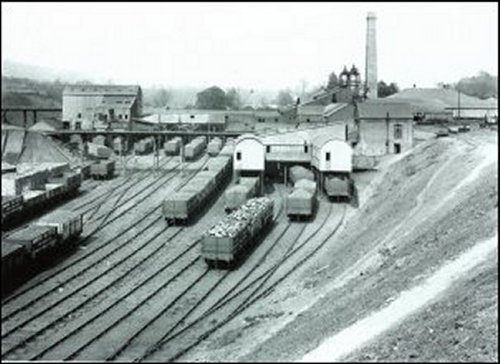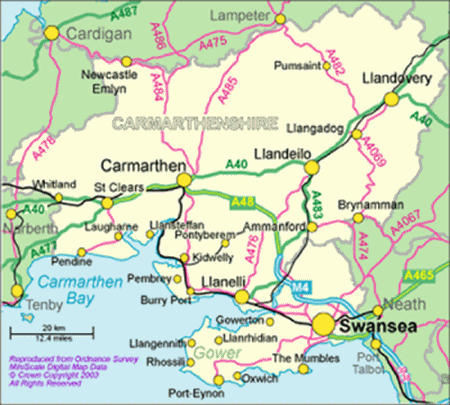Ammanford, to those who have been brought up here, is – or at least was – synonymous with coal. But that is relatively recent to the history of the area; before the mid-1800s some coal was certainly being mined from
outcrops of various seams, but for domestic use only. The economy of the district, if one could describe it as such, lay principally in farming. It was not a very thriving or rich occupation as the land was somewhat impoverished compared with the rich acres of the Towy Valley to the north or the rolling downs of the Vale of Glamorgan to the east. Nevertheless, the local inhabitants made the best of what was to hand.
The main highways went through Ammanford, not to it. The north-south road from Llandeilo and Llandybie went to Betws and the Swansea valley, and the east-west road from the Amman Valley went on to Llanelli, Swansea and beyond, both routes converging at a cross roads (now Ammanford Square). This in turn led to the development of coaching or staging inns and taverns catering for the needs of the traveller. The area eventually became identified by the name of one of these hostelries – Cross Inn.
The community of Cross Inn centred on the activity of the cross road, along with a small group of low grade cottages sited in the vicinity of Carregamman Isaf which became known as Pentrefaccas. Betws was a larger hamlet just to the south with the parish Church – St David's – as its focal point. All the area to the west of the River Amman fell within the diocese Parish of Llandybie.
The population which eventually became the administrative district of Ammanford Urban District Council in 1903 was tiny. The Reverend Rhys Powell was ordained in 1811 as the minister of Cross Inn Chapel (renamed Christian Temple in 1865) and he describes the population of Cross Inn as being around 300 during his term. The Census of 1851 confirms this in more precise terms: in 1851 Cross Inn was enumerated as part of the Parish of Llandybie. Its 59 houses accommodated just 282 inhabitants. Yet in just 100 years this would grow to 6,000 people with the most spectacular growth being from 3,058 in 1901 to 6,074 in 1911. 'Kelly's Directory for South Wales' for 1910 describes Ammanford thus:
"The parish [ie Ammanford] is governed by an Urban District Council of 15 members, formed in 1903, under the provisions of the Local Government Act, 1894. The town is lighted by electricity supplied by the Ammanford Electric Supply. The church of St. Michael's and All Angels, erected in 1885, at a cost of £1,257.7s.7d. is an edifice in the Early English style, consisting of chancel, nave, vestry, and a bell cot, containing one bell. There are 200 sittings ....... There are Wesleyan, Baptist, Congregational and Calvinistic Methodist chapels. In the parish are tinplate works and collieries. The Ivorites Hall is used for concerts, theatricals and public meetings, and will seat about 1,600 persons. A market is held here every Saturday. Brynffin is the property and residence of Lieut.-Col. David Morris. The Hon. W. F. Rice, Mrs. Jones of Carregamman, and W. N. Jones esq. J.P. are the principal landowners. The area is 878 acres; rateable value, £11,491 ; the population in 1901 was 3,500 and is now [ie in 1910] about 6,000."
Ammanford Colliery (actually in Betws) in 1912. The chimney in the background was part of a brickworks attached to the colliery. The Industrial Revolution created a demand for coal, an essential source of power to operate the boilers of its steam engines. Coal attracted investment which led to various companies, one of which was the Llanelly Railway and Dock Company, building an elaborate network of railways. The first line to reach the Amman valley was opened in 1840, linking Llanelly (as it was then spelled) with Ammanford and reaching Brynamman by 1842. Moves were soon afoot to take the railways north to the agricultural villages of Carmarthenshire and beyond. In 1857 the London Midland Service (LMS) reached Llandeilo, and Llandovery soon followed in 1858. Next, the Llandeilo to Carmarthen branch line was added to the local rail network in 1864. It would have to wait until 1868, however, before the Central Wales Extension reached Llandovery from the north but when it did, it united south western and north eastern Wales. (See the pages on Railway Stations in the 'History' section of this web site.)
Coal could not be mined without manpower and the influx of people started. People needed houses; they needed services, entertainment, schools, spiritual guidance (and activities to lure them away from spiritual guidance), and within a relatively short period of time, what was once a quiet and tranquil agricultural community changed to a throbbing town, hungry to absorb the land of those old established farmsteads. A new economy appeared on the doorstep, with the black diamond coal and its associated industries knocking for admission.
Jim Griffiths was a Betws miner who rose to become, first the Labour MP for Llanelly, next the Minister of State for National Insurance and later the first Secretary of State for Wales. In his autobiography 'Pages From Memory', published in 1969, he described Ammanford in the early twentieth century in these vivid words:
"Those were the days when coal was king and the valleys were the throne. For beneath the rugged mountains there was coal in abundance – steam coal for the navy, coking coal for the furnaces and anthracite coal for the hearth. And as the cry went out for coal and still more coal, the roads to the valleys were crowded with men in search of work and 'life'. They came from the countryside in the North and the West of the Principality and the shires across the Severn. And as they came they brought with them their way of life – the chapel and the choir, the Rechabite 'tent' preaching abstinence from drink, and the pub, the rugger ball and the boxing booth – all mixed up together. And as they settled in the valleys the cottages climbed even higher up the mountainside until the mining village looked like a giant grandstand.
The life of a collier was hard and brittle. The day's toil was long and perilous. Everyday someone would be maimed – and every year some valley would experience the agony of an explosion. Yet in spite of it all or, perhaps even because of it all, the men and women who came to the valley created a community throbbing with life. Thrown together in the narrow valley, cut off from the world outside, they clung together fiercely, sharing the fellowship of common danger. Life in the valleys has a magic of its own, and to us who grew up in the glow of its fires there comes a nostalgic longing – 'hiraeth' as they say in our mother language – of the fellowship of long ago."
That world and its people are long gone and history can only hint at what life was like in those days. A few old photographs here, some stories there, and a few facts and figures elsewhere may not be the real thing but we have no other way of revisiting the past. Perhaps a stroll through the pages and photographs of this website will flesh out just a bit the hazy picture of the little town of Ammanford nestling beneath the rugged mountains and of the fellowship of long ago.


